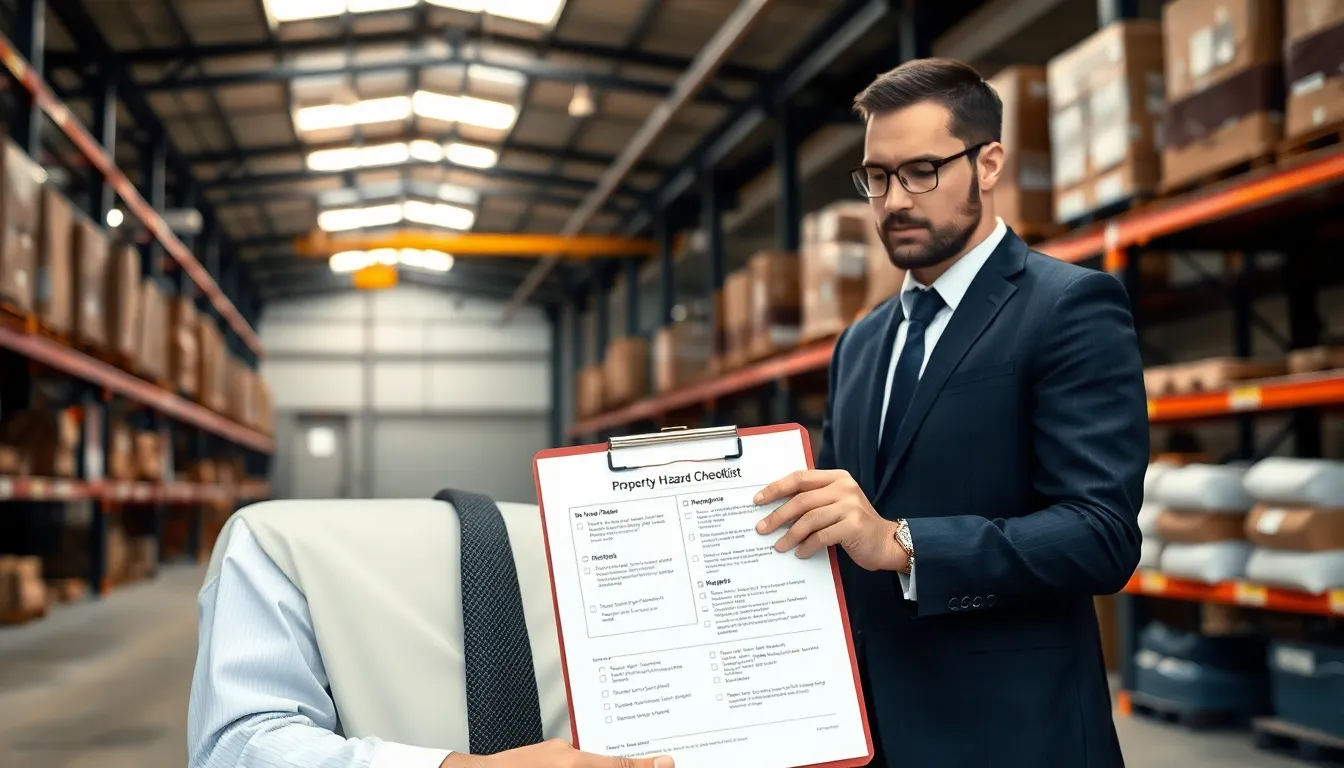When it comes to property management, a little humor goes a long way—especially when navigating the maze of potential hazards lurking around every corner. Picture this: you’re inspecting your property, and suddenly you trip over a rogue garden gnome. Not the ideal way to uncover safety issues, right? That’s where property hazard checklists come in, transforming what could be a comedy of errors into a streamlined safety assessment.
These checklists aren’t just a boring list of do’s and don’ts; they’re your trusty sidekick in the quest for a safe and secure environment. From identifying fire hazards to spotting slippery floors, a well-crafted checklist can save the day and possibly your sanity. So buckle up and get ready to turn your property inspections from a potential sitcom into a smooth operation that keeps everyone safe and sound.
Table of Contents
ToggleOverview of Property Hazard Checklists
Property hazard checklists play a critical role in maintaining safety in any property management scenario. These tools systematically identify potential risks, ensuring nothing goes unnoticed during inspections. Essential items often included in these lists are fire alarms, electrical wiring, and emergency exits.
Fire hazards constitute one of the highest priorities within these checklists. Managers routinely check for faulty wiring and the presence of flammable materials. Slipping and tripping hazards appear frequently, so it’s important to assess walkways and common areas for uneven surfaces or clutter. Regular review of these elements can prevent accidents and injuries.
Moreover, property hazard checklists help managers comply with legal safety regulations. By documenting findings and actions taken, they create a record that can assist during audits or inspections by relevant authorities. Compliance with rules not only promotes safety but also minimizes potential liabilities.
Signs of wear or damage should also prompt immediate attention. Regular replacement of worn-out safety features contributes significantly to overall property security. Additionally, environmental factors, including drainage and landscaping, play a part in the safety equation. Effective checklists incorporate assessments of these elements, thus maintaining the property’s appeal and safety.
Adopting structured property hazard checklists enhances safety and organizational efficiency in property management. They transform inspections from chaotic tasks into systematic procedures, reinforcing the commitment to a secure environment for all occupants.
Importance of Property Hazard Checklists

Property hazard checklists prove vital for maintaining safety and preventing accidents within properties. Utilizing these tools allows property managers to identify risks systematically.
Risk Management
Identifying potential hazards reduces the likelihood of accidents and injuries. A thorough checklist uncovers fire risks, electrical issues, and trip hazards. Sensors for smoke detection or signs warning of slippery surfaces appear frequently on these lists. Addressing these items promptly contributes to overall safety. Effective risk management reduces liability exposure for property owners. Regular inspections not only uncover issues but also encourage proactive maintenance practices.
Regulatory Compliance
Meeting legal safety requirements remains critical for property managers. Checklists assist in documenting inspections, findings, and corrective actions, helping maintain records for audits. Compliance with local and state regulations often hinges on demonstrating adherence to safety protocols. Property managers can avoid fines and penalties by ensuring all necessary safety features, such as fire alarms and emergency exits, meet standards. Maintaining these documents fosters transparency in property management practices. Safety regulations evolve, so routine updates to checklists ensure ongoing compliance.
Types of Property Hazards
Property hazards come in various forms, each requiring specific attention during inspections. Identifying these hazards ensures a safer environment for both residents and property managers.
Physical Hazards
Physical hazards encompass conditions that can cause injuries. Uneven walkways, poorly lit areas, and loose handrails frequently contribute to falls. Fire exits and emergency escape routes must remain unobstructed to facilitate quick evacuations during emergencies. Inspecting building structures for signs of wear, like cracks or roof leaks, also plays a crucial role in maintaining safety. Regular maintenance strengthens resilience against these risks.
Chemical Hazards
Chemical hazards pose serious risks within properties, often stemming from cleaning agents, pesticides, or industrial materials. Proper storage and labeling of these substances are vital to prevent accidental exposure. Regularly checking for leaks in gas lines or chemical containers can avert dangerous situations. Emergency response procedures for chemical spills should be in place and communicated to all occupants. Awareness of Material Safety Data Sheets enhances safety protocols by providing essential information on hazardous materials present.
Biological Hazards
Biological hazards include mold, bacteria, and pests that can threaten health. Ensuring adequate ventilation reduces moisture and limits mold growth within properties. Routine inspections for infestations of rodents or insects help maintain a hygienic environment. In addition, employing proper pest control methods minimizes health risks associated with biological contaminants. Training staff on sanitation practices fosters awareness and responsiveness to biological hazards, promoting overall safety within the property.
Creating Effective Property Hazard Checklists
Creating property hazard checklists involves systematic approaches to ensure safety and compliance.
Identifying Hazards
Tracking hazards begins with a thorough assessment of the property. Fire alarms, electrical wiring, and emergency exits are key areas to investigate. Uneven walkways and poorly lit areas pose physical risks, while cleaning agents may create chemical hazards if improperly stored. Biological threats like mold require regular inspections and adequate ventilation. Collecting data on various hazards creates a comprehensive overview, aiding in the recognition of conditions that may precipitate accidents.
Prioritizing Risks
Prioritization of identified risks is crucial for effective management. Assessing risks based on severity and likelihood helps determine immediate actions. Fire hazards, for example, often require urgent attention due to their potential for catastrophic consequences. Similarly, trip hazards in high-traffic areas must be addressed swiftly to minimize injury risk. Organizing risks in a tiered manner simplifies the decision-making process and enables focused resource allocation, leading to enhanced safety measures.
Reviewing and Updating Checklists
Regular reviews of checklists keep them relevant and effective. Property conditions evolve, requiring adjustments to inspection criteria. Incorporating feedback from recent inspections can identify gaps in previously established processes. Additionally, staying informed about new safety regulations must drive updates to checklists. Routine evaluations foster a culture of safety awareness, ensuring property managers maintain high standards for risk mitigation and compliance.
Best Practices for Implementing Checklists
Creating effective checklists requires a systematic approach to property safety. Prioritize hazards based on their severity and likelihood. Conduct thorough assessments of the property to identify specific risks. Implementing a feedback loop from inspections contributes to continuous improvement.
Regularly review and update checklists to align with evolving safety regulations and best practices. Incorporate data from previous inspections to enhance the checklist’s effectiveness. Training staff on proper checklist utilization optimizes the inspection process and promotes accountability.
Engage property management teams in discussions about potential hazards to foster teamwork. Utilize technology, such as digital checklists, to streamline data collection and analysis. Ensure documentation of findings and corrective actions is consistently maintained for compliance purposes.
Addressing hazards promptly reduces the risk of accidents and liabilities. Establishing a routine inspection schedule helps maintain property quality and safety. Collaborate with safety experts for advice on industry standards that enhance checklist reliability.
Setting clear responsibilities for inspection tasks ensures thorough coverage of all risks. Assessing the environment, including drainage and landscaping, plays a crucial role in identifying hazards. Integrating checklists into daily operations promotes a culture of safety within property management.
Utilizing property hazard checklists is crucial for effective property management. These tools not only enhance safety but also streamline inspections and ensure compliance with regulations. By systematically identifying potential risks and addressing them promptly, property managers can foster a secure environment for tenants and visitors alike.
Regular updates and staff training on these checklists promote a proactive safety culture. Embracing technology for checklist management further simplifies documentation and enhances accountability. Ultimately, a well-implemented property hazard checklist transforms safety inspections into organized assessments, significantly reducing the risk of accidents and liabilities.





